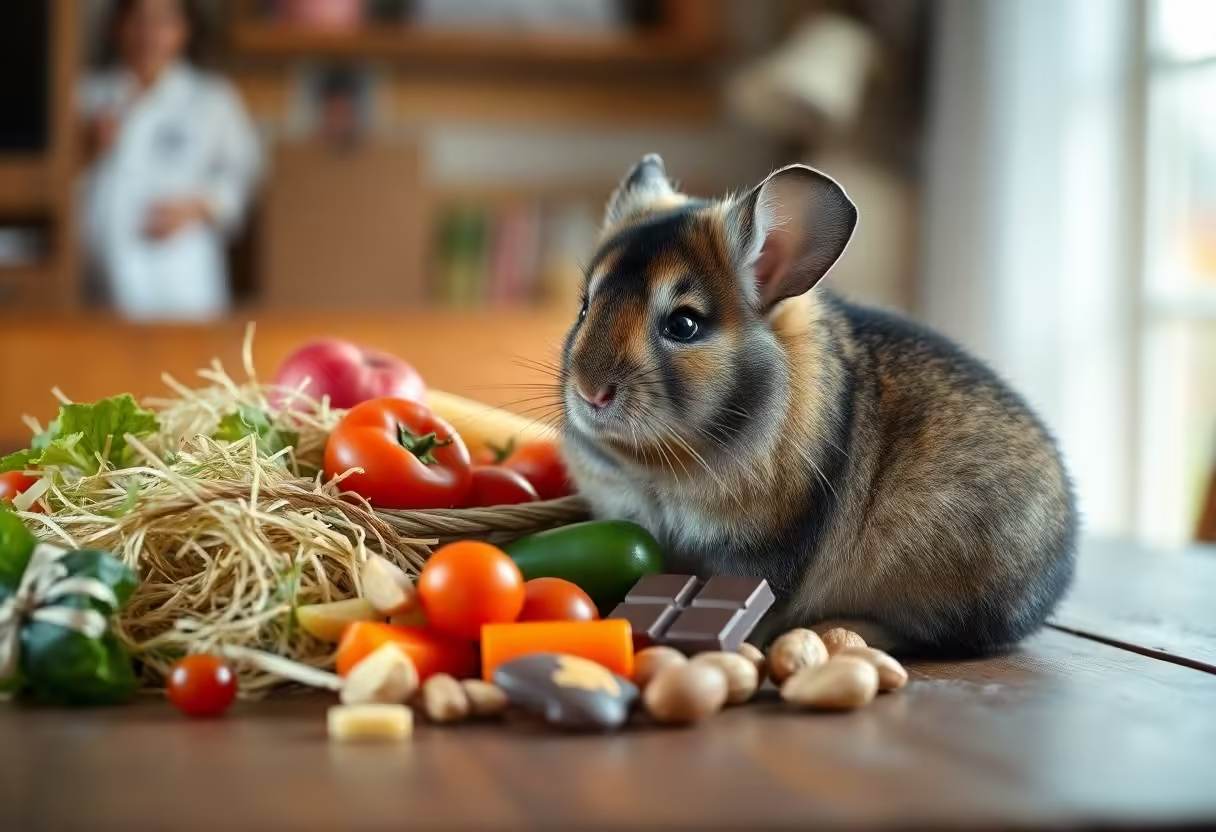Ensuring your chinchilla’s diet is balanced and appropriate is crucial for their health and longevity. Chinchillas have specific dietary requirements that focus on high-fiber foods, minimal sugars, and no harmful treats. This guide provides essential information about what chinchillas can and cannot eat, helping you create a diet plan that promotes their well-being.
Key Takeaways
- Hay: Unlimited timothy hay or orchard grass is vital for digestive health and dental care.
- Pellets: High-quality, chinchilla-specific pellets with 20% fiber content are essential.
- Treats: Safe treats include dried herbs and flowers, but these should be offered sparingly.
- Avoid: Sugary, fatty, and processed human foods, along with toxic items like chocolate and avocado.
Safe and Unsafe Foods for Chinchillas
The following table summarizes safe foods for chinchillas, including recommended portion sizes and frequency, alongside unsafe items to avoid.
| Food | Portion Size | Frequency | Notes |
|---|---|---|---|
| Timothy Hay | Unlimited | Daily | Essential for dental and digestive health. |
| Bell Peppers | 1 slice | Occasionally | High in Vitamin C, low in oxalic acid. |
| Carrots | 1 slice or 1 baby carrot | Occasionally | High in sugar—limit intake. |
| Parsley | 2–4 sprigs | Every few days | High in calcium; feed sparingly. |
| Blueberries | 1–3 berries | Occasionally | High in sugar—limit as a treat. |
| Spinach | 1 leaf | 2–3 times per week | High in oxalic acid; pair cautiously. |
| Chocolate | None | Never | Toxic to chinchillas. |
| Avocado | None | Never | Toxic; avoid entirely. |
| Processed Foods | None | Never | Includes bread, pasta, and sugary snacks. |

Safe Foods for Chinchillas
Hay and Grass
Hay is the cornerstone of a chinchilla’s diet, offering critical nutrients and aiding digestion. Unlimited access to timothy hay or orchard grass helps wear down their teeth naturally, preventing dental issues.
Fresh Vegetables
While not a primary food source, fresh vegetables can be offered as occasional treats. Safe options include:
- Leafy greens: Romaine lettuce, cilantro
- Non-starchy vegetables: Kale, bell peppers
Limit portions to small amounts to avoid digestive upset, and introduce new vegetables gradually. Always wash vegetables thoroughly before feeding.
Pellets
A good chinchilla pellet should:
- Contain 20% fiber or higher.
- Be free of seeds, nuts, or sugary additives.
- Be made primarily from hay.
Feed 1–2 tablespoons of pellets daily, ensuring they complement a hay-based diet.
Safe Treats
Chinchillas can have treats in moderation. Suitable options include:
- Dried flowers: Hibiscus, rose petals
- Dried fruit (in tiny portions): Apple slices
- Dried herbs: Chamomile, mint
Foods to Avoid
Toxic Foods
Never feed chinchillas the following, as they are toxic:
- Chocolate
- Avocado
- Certain nuts (e.g., almonds, peanuts)
Harmful Human Foods
Chinchillas have delicate digestive systems and cannot handle sugary, fatty, or salty human foods. Harmful items include:
- Sugary snacks: Candy, baked goods
- Fatty foods: Potato chips, fried items
- Processed foods: Bread, pasta
Fruits and Nuts
While some fruits and nuts may seem harmless, they are often high in sugar or fat, which can lead to obesity and gastrointestinal issues. Avoid bananas, grapes, and all nuts.
Feeding Tips and Guidelines
Daily Routine
- Hay: Provide unlimited fresh hay every day.
- Pellets: Limit to 1–2 tablespoons daily.
- Water: Ensure constant access to fresh, clean water.
- Treats: Offer sparingly, no more than a teaspoon per day.
Portion Control
Monitor portions carefully to prevent obesity and digestive problems. Using a kitchen scale can help you measure treats and pellets accurately.
Feeding Schedule
Feed your chinchilla at the same time each day to establish a routine. Consistency promotes better eating habits and allows you to monitor changes in their appetite.
Signs of Dietary Issues
Physical Symptoms
Watch for:
- Weight loss or gain
- Diarrhea or irregular bowel movements
- Refusal to eat or drink
Behavioral Changes
Changes in mood or activity levels can indicate dietary issues. Look out for:
- Increased irritability
- Decreased playfulness
- Withdrawal or aggression
Final Words
To ensure your chinchilla thrives, focus on a diet of high-quality hay, limited pellets, and occasional treats. Avoid toxic or sugary foods, and consult your veterinarian if you’re ever unsure. With the right care, your chinchilla can live a happy, healthy life.
FAQs
Q: What should a chinchilla’s primary diet consist of?
A: A chinchilla’s diet should primarily include unlimited timothy hay or orchard grass, along with high-quality pellets. Occasional vegetables or dried herbs can be offered as treats.
Q: What foods are toxic to chinchillas?
A: Toxic foods include chocolate, avocado, and certain nuts. Avoid all human foods high in sugar, fat, or salt.
Q: Can chinchillas eat fresh vegetables?
A: Yes, but in moderation. Safe options include leafy greens like romaine lettuce and non-starchy vegetables like bell peppers.
Q: What are safe treats for chinchillas?
A: Safe treats include dried flowers (e.g., hibiscus), dried herbs (e.g., chamomile), and tiny portions of dried fruits like apple slices.
Q: How much food should I feed my chinchilla daily?
A: Provide unlimited hay, 1–2 tablespoons of pellets, and an occasional treat (no more than a teaspoon).
Citation
Safe food data adapted from the SPCA of Wake County’s “Fruits & Vegetables Chart for Small Pets.”
